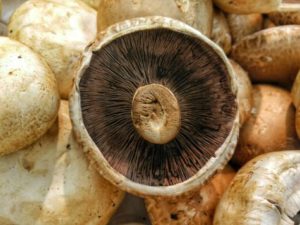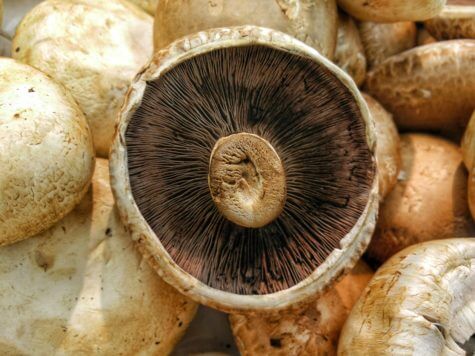STATE COLLEGE, Pa. — Mushrooms may make our favorite pizza and pasta dishes taste delightfully better, but it turns out they may help keep our brains and hearts younger too. A new study finds that some of our favorite toadstools may have high concentrations of antioxidants with anti-aging benefits.
Researchers at Penn State analyzed the chemical composition of a wide variety of types of mushrooms, finding that many contained high levels of ergothioneine and glutathione, both of which are important antioxidants.

“What we found is that, without a doubt, mushrooms are highest dietary source of these two antioxidants taken together, and that some types are really packed with both of them,” says lead researcher Robert Beelman in a university news release.
It is widely accepted that the human body’s chemical process of converting food into energy produces free radicals, which can cause damage to cells, protein, and DNA, the researchers explain.
“There’s a theory — the free radical theory of aging — that’s been around for a long time that says when we oxidize our food to produce energy there’s a number of free radicals that are produced that are side products of that action and many of these are quite toxic,” says Beelman.
Eventually, an accumulation of free radicals can lead to chronic disease and illness, including “cancer, coronary heart disease, and Alzheimer’s,” he adds. Ergothioneine and glutathione can help control those free radicals.
Beelman and his team found that the quantity of antioxidants in certain species varied, with the porcini species, which is a wild variety, carrying the highest amount of both ergothioneine and glutathione.
“This species is really popular in Italy where searching for it has become a national pastime,” Beelman says.
Meanwhile, some garden-variety types of mushroom, such as the white button, had fewer antioxidants, although more than most foods.
Interestingly, there was little evidence that cooking mushrooms significantly changed the composition of their antioxidants, particularly as it pertained to ergothioneine.
Future research could look into the ability of ergothioneine and glutathione to help prevent neurodegenerative disease, such as Parkinson’s and the aforementioned Alzheimer’s, Beelman suggests.
“It’s preliminary, but you can see that countries that have more ergothioneine in their diets, countries like France and Italy, also have lower incidences of neurodegenerative diseases, while people in countries like the United States, which has low amounts of ergothioneine in the diet, have a higher probability of diseases like Parkinson’s Disease and Alzheimer’s,” Beelman notes.
Although the relationship between mushroom consumption and neurodegeneration may be one of correlation, instead of causation, it would only take about five button mushrooms a day for Americans to close the gap, he adds.
The study’s findings were published last month the journal Food Chemistry.

Do Psilocybin mushrooms contain these ingredients?
I ate some last weekend & my mind was blown in a good way.
I prefer to brew mushroom tea with my psilcybe mushrooms
Love the magic shroomies! Don’t know if they contain those two antioxidants, but they are becoming very useful in treating depression and PTSD.
Thing is, if they don’t have anti oxidant properties, you won’t care much. Seems like a win.
If you like mushrooms and think this is good news for you, or even if you don’t like them, just wait. Eventually, they will cause cancer just like everything else: Butter, Margarine, alcohol, meat, breathing.
Here it is being used to fight antioxidants. The same antioxidants that fight cancer cells.
No, it’s the other way round. The body uses reactive oxygen species to execute them:
“Production of ROS by neutrophils and macrophages as a mechanism to kill tumor cells is well established. In these cells, a rapid burst of superoxide formation primarily mediated by NAPDH oxidase leads to subsequent production of hydrogen peroxide. Furthermore, during inflammation processes, activated macrophages also generate nitric oxide which reacts with superoxide to produce peroxinitrite radicals that are similar in their activity to hydroxyl radicals and contribute to tumor cell apoptosis.”
https://www.ncbi.nlm.nih.gov/pmc/articles/PMC3880197/
Antioxidants, and glutathione in particular, can protect cancer cells:
https://www.scientificamerican.com/article/antioxidants-may-make-cancer-worse/
I’ve always done mushrooms…especially in my Tyson cocaine days in Arkansas.
Hillary’s always preferred toad sucking.
You worked at Tyson?
Worked at Tyson? Ha! Never worked a day in my life.
Partied with my bro’ Roger (nose like a Shop-Vac) and the Tysons, but never worked at all.
Check with Susan McDougal. Ya cain’t talk to Jim, Dan Lasater, or Vince Foster anymore.
Your bill Clinton?
you mean Toadstool sucking, right…?
ya need to cook them, however slightly for full benefit. see Dr. Fuhrman’s Nutritarian books for a full explanation.
“‘This species [porcini] is really popular in Italy where searching for it has become a national pastime,’ Beelman says.” That mushroom is popular in many European countries, and forging for them is popular in many European countries. Why make is seem as though Italy is unique in both regards?
Most likely since Italy has the longest lifespan in Europe, and second only to Japan in the world.
In Europe, Switzerland and Spain have longer life expectancies than Italy. And Iceland is tied with Italy. I suspect that citing only Italy is for the same reason that cooking websites cite the same thing about the mushrooms: ignorance of other countries.
It all depends on whose study you are using as a basis. Italy has traditionally been at the top of the list, although this can change from year to year. As far as cooking is concerned, you may attribute the references to popularity and laziness on the part of the author. Porcini is also the Italian name for that variety of mushrooms.
My lady is going to live a long time because she’s all over my mushroom.
My sainted father always said, “He who drinketh from fur cup, liveth longest.”
I don’t know about fountain of youth benefits, but since I started taking powdered mushrooms by Host Defense years ago, I am rarely sick. I used to get everything. A coincidence? Maybe, maybe not.
And the essential oils? And the warm, fresh blood baths? Come on, tell us everything!
Those, too.
The article says white button mushrooms have less antioxidants, then at the end of the article it says that it only takes 5 button mushrooms to close the gap. It also says that cooking affects the process but it doesn’t say how. It would be nice if the article would state which mushrooms are best. 5yr.olds shouldn’t be allowed to write articles.
I thought that was really STOOPID, not saying how cooking affects them—what Lone said there….
“there was little evidence that cooking mushrooms significantly changed the composition of their antioxidants”
In other words, cooking does NOT appear to affect them.
thanks.
It said porcini mushrooms were best. Need glasses?
Thanks, I missed that.
Yeah, but they work for cheap, especially the Orientals.
What about the brown mushrooms (Cremini)? I eat them regularly… sauteed in butter and garlic. YUM
The popular press takes for granted that oxidative stress is the gravamen of the aging process while the lead author judiciously refers to a theory that’s been around for a long time. If dietary antioxidants were the fountain of youth the legion of hacks pumping out nutriporn hold it out as one would think that by now there would be clear-cut evidence of benefit. and there is–to those who profit from hyping them. Medically, not so much. The USDA removed the table showing the Oxygen Radical Absorbance Capacity (ORAC) of Selected Foods Release 2 (2010) table due to the lack of evidence that the antioxidant level present in a food translated into a related antioxidant effect in the body.
https://www.hsph.harvard.edu/nutritionsource/antioxidants/
I don’t dismiss their significance in health and disease but note that there are other facets of nutrition where the jury is in.
There is also the issue of prevention versus treatment. Would not oxidative stress be better managed by avoidance? Is it not better to avoid poison than to take it along with putative antidotes of dubious efficacy? Most reactive oxygen species react with the first thing they encounter, so reducing their production is clearly preferable to trying to quench them after they are formed in a target-rich environment. Simply not overeating, getting enough sleep, and managing stress are all effective, as is ensuring adequate magnesium status.
Yeah, what Lew said there….
Many mushrooms also contain the cancer causing chemical family Hydrazines.
A cost / benefit analysis is needed here.
Other mushrooms are known to cause neurogenesis (neuronal growth), too.
Neurogenesis refers to the birth rather than growth of neurons. If one desires enhanced neuroplasticity via neuronal growth (dendritic elongation and ramification), the indicated intervention is acetyl-L-carnitine arginate dihydrochloride.